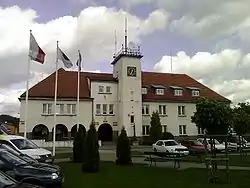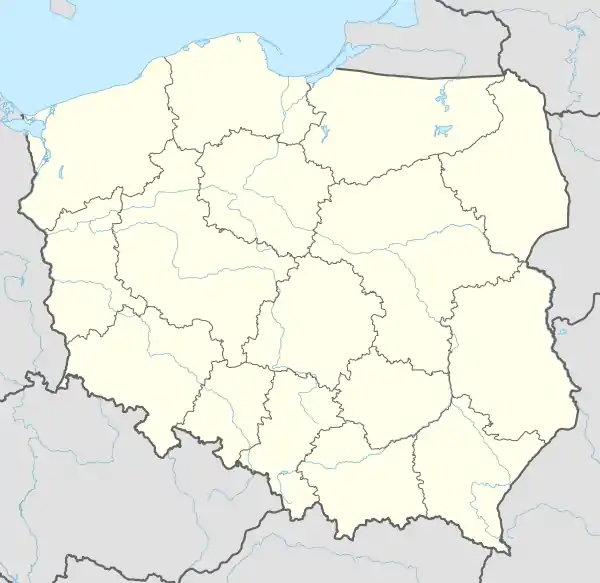Łabiszyn
Łabiszyn [waˈbʲiʂɨn] (German: Labischin, 1940-45: Lüderitz) is a small town in Żnin County, in the Kuyavian-Pomeranian Voivodeship in Poland, with 4,403 inhabitants (2004). It is located on the Noteć river near Żnin.
Łabiszyn | |
|---|---|
 Town hall | |
 Flag  Coat of arms | |
 Łabiszyn | |
| Coordinates: 52°57′11″N 17°54′52″E | |
| Country | |
| Voivodeship | Kuyavian-Pomeranian |
| County | Żnin |
| Gmina | Łabiszyn |
| Area | |
| • Total | 2.89 km2 (1.12 sq mi) |
| Population (2006) | |
| • Total | 4,473 |
| • Density | 1,500/km2 (4,000/sq mi) |
| Postal code | 89-210 |
| Website | http://www.labiszyn.pl |
History
The first written mention of Łabiszyn comes from the 13th century as an estate owned by a knight. A document from 1247 mentions Dezydery of Łabiszyn, probably the owner of the settlement. In 1362 the village is mentioned as Labissino and Lambissiono.[1] In the 14th century, Łabiszyn belonged to the Prawdzic family. Thanks to their efforts, the settlement and the castle were granted town rights in 1369. In 1407, the town already had its own wax seal with the coat of arms depicting the right, open and severed hand with the inscription "Łabiszyn". King Władysław Jagiełło passed through Łabiszyn on November 2, 1410 , on his way from Inowrocław to Szubin after the victorious Battle of Koronowo. According to tradition, Jagiełło planted two oaks on the Łabiszyński Hill, one of which has survived to this day.
In the years 1604-1610, the owner of the town with the castle and the surrounding villages was Andrzej Czarnkowski, the voivode of Kalisz. From the 16th to the 19th century, the town was owned by the Czarnkowski, Opaliński, Gembicki and Skórzewski families. In 1678, the castellan Paweł Gembicki confirmed the town rights for Łabiszyn. In the 17th and 18th centuries, the town was devastated by fires and plagues. With the annexation of the town by Prussia in the 18th century, Protestant clothiers from Germany began to arrive. On September 30, 1794, during the Kościuszko Uprising, the troops of General Henryk Dąbrowski defeated the Prussian army near Łabiszyn and captured the town, which was defended by the Prussian garrison of Lieutenant Beyer. Another battle with the Prussian army near Łabiszyn took place in 1848, during the Spring of Nations.
Under Prussian rule, the town was part of Kreis Schubin in the Province of Posen until 1919. It was also part of the German Empire from 1871. According to the German census of 1890, the town had a population of 2,328, of which 900 (38.7%) were Poles.[2] In the aftermath of World War I, the town's inhabitants played an important role in the Greater Poland uprising (1918-19). In 1919, the Łabiszyn insurgents won a decisive victory against the Germans and the town became part of the newly established Second Polish Republic.
After the invasion of Poland in 1939, the town was occupied by Nazi Germany. In 1940, the Germans renamed the town Lüderitz, in memory of Adolf Lüderitz, founder of the German South West Africa colony. Towards the end of World War II in 1945, the town was captured by the Red Army and restored to Poland.
References
- Wuttke, Heinrich (1864). Codex diplomaticus magni ducatus Posnaniensis (in German). Fries.
- "Deutsche Verwaltungsgeschichte Provinz Posen, Kreis Schubin". treemagic.org. Retrieved 2021-01-19.
